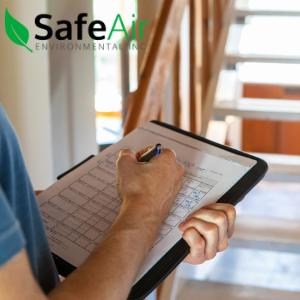How You Can Improve Your Indoor Air Quality
Posted in Air Quality, on May 03, 2021
 During the COVID-19 pandemic, we've all been paying extra attention to our respiratory health and how it's affected by our surroundings. Home air quality testing is a fantastic tool for any homeowner interested in making positive changes to the indoor air environment. It's a safe and non-invasive way to measure pollutants, toxins, allergens, dust, or mold spores or look for more specific issues, such as radon testing. Regardless of your concerns, improving your indoor air quality testing has positive effects on more than just your lungs — it can improve your sleep, concentration and reduce the impact of chronic conditions like asthma.
During the COVID-19 pandemic, we've all been paying extra attention to our respiratory health and how it's affected by our surroundings. Home air quality testing is a fantastic tool for any homeowner interested in making positive changes to the indoor air environment. It's a safe and non-invasive way to measure pollutants, toxins, allergens, dust, or mold spores or look for more specific issues, such as radon testing. Regardless of your concerns, improving your indoor air quality testing has positive effects on more than just your lungs — it can improve your sleep, concentration and reduce the impact of chronic conditions like asthma.
Know What Good Air Quality Is
When asked what good air quality is, many of us wouldn’t know what to say — it’s only been in the last 10-15 years that indoor air quality has become a key part of good health and safety at home. After decades of focus on outdoor pollution like smog or haze, many homeowners in the GTA are looking closer to home for ways to support their family’s health.
A home with good indoor air quality has:
No smells, artificial or otherwise
Less pollen, dust or dander
No VOCs or other harmful chemical residues
No mold or radon gas
Good ventilation
No lead paint
Tests negative for asbestos
Has balanced humidity
Many of these pollutants are invisible or difficult to sense — which is where home air quality testing can help!
What is Air Quality Testing?
A home air test measures indoor levels of specific or general air pollutants. At SafeAir, we generally do visual inspections both inside and outside your home as part of our home air quality testing. Air or physical samples are taken from different rooms and sent to a lab for analysis. Then we share all our findings in easy-to-understand language and help guide you towards improvements that can reduce or eliminate any issues that we uncover. Do you have a specific concern? Mold or radon testing are two examples of specialized indoor air quality tests that we perform.
5 Simple Steps to Improve Indoor Air Quality
1. Freshen Up Your Floors
Allergens and irritants can linger on flooring despite your best efforts. At SafeAir, we recommend a three-pronged approach to floor cleanliness. The first step is to put a floor mat at every door out of your home. This mat will catch dirt, allergens, and chemicals, preventing them from coming further inside. Next, we suggest regular sweeping and weekly vacuuming to remove dirt and particles that may be irritating. If you can, buy a vacuum with a HEPA filter, which is specially made to capture tiny particles. Lastly, follow up your vacuuming with a good mop, which will pick up all the fine dust that the vacuum leaves behind.
2. Ventilation and Fresh Air
The key to good indoor air quality is to have lots of air movement. Stagnant air is one of the most significant factors that cause problems such as mold growth, in part because it magnifies underlying causes like moisture or VOCs. Without fresh or moving air to help dry water up or move allergens along, indoor air pollutants tend to collect, and health issues can become amplified.
3. Healthy Humidity Levels
A humid home is physically uncomfortable, but it can also exacerbate issues like mold growth. At SafeAir, we recommend keeping your indoor humidity balanced at around 50%. You can purchase inexpensive stand-alone monitors at the hardware store to help you monitor different spaces.
4. Smoke-Free Zone
The most significant indoor air pollutant is second-hand cigarette smoke. Make it a household rule to only smoke outdoors and keep the more than 4000 chemicals founds in smoke out of your indoor air quality.
5. Monitor Common Pollutants
There are several inexpensive ways to monitor common issues or pollutants at home. We've already mentioned humidity monitors, but your hardware store should have a range of equipment that can help you keep an eye on contaminants like formaldehyde, radon, particulates, and VOCs. In Ontario, it's also the law to have a working smoke alarm and carbon monoxide detector installed, and every year these inexpensive devices save hundreds of lives.
Work With SafeAir to Improve your Home Air Quality
As you can see from our list of simple ways to improve your home air quality, solutions to indoor pollution don’t have to be expensive or disruptive — sometimes all that’s needed are small habit shifts. Home air quality testing is the best way to get definitive answers about what’s happening in your home environment and how you can make your living environment safe for work and play. To learn more about general indoor air quality testing or specialized programs such as radon testing, call our office at 416-414-5690.

